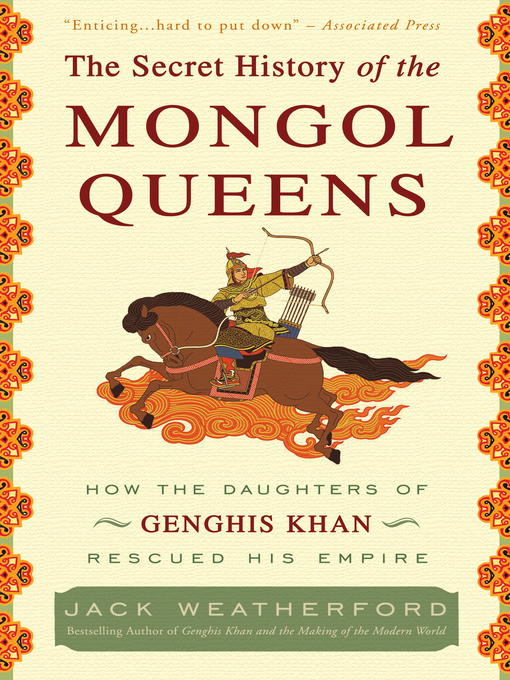- Featured Magazines
- Let's Get Cooking!
- News, Politics, and Business
- Lifestyle Magazines
- Popular Magazines
- All Magazines
- See all magazines collections
The Secret History of the Mongol Queens
How the Daughters of Genghis Khan Rescued His Empire
“Enticing . . . hard to put down.”—Associated Press
The Mongol queens of the thirteenth century ruled the largest empire the world has ever known. The daughters of the Silk Route turned their father’s conquests into the first truly international empire, fostering trade, education, and religion throughout their territories and creating an economic system that stretched from the Pacific to the Mediterranean.
Yet sometime near the end of the century, censors cut a section about the queens from the Secret History of the Mongols, and, with that one act, the dynasty of these royals had seemingly been extinguished forever, as even their names were erased from the historical record.
With The Secret History of the Mongol Queens, a groundbreaking and magnificently researched narrative, Jack Weatherford restores the queens’ missing chapter to the annals of history.
-
Creators
-
Publisher
-
Release date
February 16, 2010 -
Formats
-
Kindle Book
-
OverDrive Read
- ISBN: 9780307589361
-
EPUB ebook
- ISBN: 9780307589361
- File size: 5250 KB
-
-
Languages
- English
-
Reviews
-
Kirkus
November 1, 2009
Genghis Khan as the first feminist patriarch.
Weatherford (Anthropology/Macalester Coll.; Genghis Khan and the Making of the Modern World, 2004, etc.) asserts that the founder of the Mongol Empire learned from harsh experience not to trust the men within the warring steppe clans, and eventually left his extended empire in the hands of his more capable daughters. Their husbands and in-laws, in turn, savagely wrested power from the women, excised their existence from official accounts and left the empire in alarming decline over centuries—until the reign of the last great Mongol queen Manduhai the Wise, who restored Mongol power in the 15th century and drove back the incursions by the Chinese. In the first part of the book, Weatherford traces the life of Genghis Khan and his relationship with his children, probably four sons and seven or eight daughters, as later recorded in The Secret History of the Mongols in the 13th century. This document sets forth the patriarch's intentions for his family and nation, but it is curiously missing the part of the text that completes this intriguing sentence:"Let us reward our female offspring." Weatherford argues that Genghis maintained a staunch adherence to a male-female sharing of power. Girls were raised to ride and shoot like boys, and they were expected to rule a territory as rigorously as they ruled the home. As part of his strategy to tighten his hold along the Silk Route, Genghis married his daughters to leaders in recently vanquished foreign lands to rule in his stead. Weatherford amply demonstrates how subsequent male relations waged a backlash against these women rulers until the remarkable rise of Manduhai and her ability to reunite the squabbling Mongol tribes.
Uplifting, entertaining history.(COPYRIGHT (2009) KIRKUS REVIEWS/NIELSEN BUSINESS MEDIA, INC. ALL RIGHTS RESERVED.)
-
Library Journal
Starred review from December 15, 2009
Genghis Khan not only reigned by conquest but by using his female relatives to help expand and stabilize the Mongol Empire. Using sources that range from Chinese diplomatic reports to a text called "The Secret History of Mongols" to Italian letters to the Vatican, Weatherford (anthropology, Macalester Coll.) describes how Khan married off his daughters to the rulers of different kingdoms along the Silk Road and then sent his new sons-in-law off to war, thereby leaving his daughters to rule. From these daughters and their descendants, including the intriguing Queen Manduhai (whose raiding influenced the decision to build parts of the Great Wall of China during the Ming dynasty), we see what an important role these royal women played in Mongol and world history. VERDICT Highly recommended for all readers, especially students of history, Asian studies, or women's studies, wanting to learn more about these Mongol women, who have been studied less than their famous father.Melissa Aho, Bio-Medical Lib., Univ. of Minnesota, MinneapolisCopyright 2009 Library Journal, LLC Used with permission.
-
Booklist
January 1, 2010
Though the prolific Genghis Khan fathered numerous sons and daughters, historians have dutifully recorded the foibles and follies of his male heirs while virtually ignoring the accomplishments of his female offspring. Weatherford seeks to remedy this glaring omission by providing a fascinating romp through the feminine side of the infamous Khan clan. Surprisingly, old Genghis himself seems to have been impressed enough by the leadership abilities of his womenfolk to want to reward some of them with pieces of his vast empire. At least four of his daughters became queens of their own countries, exercising power over their courts, their armies, and, of course, their families. Important linchpins in the Mongol Empire, these women supplied the balance of power necessary to appease fractious tribes and territories. Unfortunately, soon after Genghis Khans death, the female rulers were challenged by their male relatives, and the fragile bonds that held the Mongol Empire together quickly disintegrated. Ironically, it wasnt until the emergence of a new queen, two centuries later, that the once-mighty Mongol nation was reunited. Lets hear it for the girls.(Reprinted with permission of Booklist, copyright 2010, American Library Association.)
-
Formats
- Kindle Book
- OverDrive Read
- EPUB ebook
Languages
- English
Loading
Why is availability limited?
×Availability can change throughout the month based on the library's budget. You can still place a hold on the title, and your hold will be automatically filled as soon as the title is available again.
The Kindle Book format for this title is not supported on:
×Read-along ebook
×The OverDrive Read format of this ebook has professional narration that plays while you read in your browser. Learn more here.



